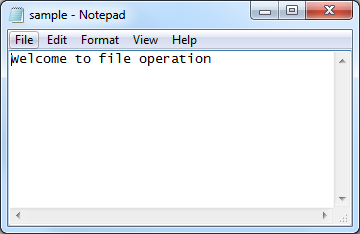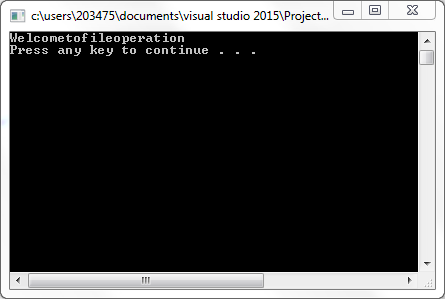
What capability does the fstream data type provide that the ifstream and ofstream data types do not?
Explanation of Solution
Header file used to perform file operations:
“fstream” (file stream) is the standard header file in C++ used to perform file operations such as file creation, write information to the file and read information from the file.
ofstream:
“ofstream” is a data type that represents output file stream used to create files and write information to files using output file stream object.
A file where the data are written is called as output file. When a program stores the output in a file, then it is called as output file.
ifstream:
“ifstream” is a data type that represents input file stream used to read information from files using input file stream object.
A file from which the data is read is called as input file. When a program gets input from the file, then it is called as input file.
Therefore, the data type “fstream” performs both read and write operation whereas the data type “ifstream” will perform only a read operation and the data type “ofstream” performs the write operation.
Example program:
The below code is an example for the “ifstream” usage to read information from file:
//Include the necessary header files
#include <iostream>
//Header file used to perform “file operations”
#include <fstream>
#include<string>
using namespace std;
// Main function
int main()
{
string str= "sample.txt";
//Create object for ofstream
ofstream out(str.data());
/*Write information to the file using ofstream object “out”*/
out << "Welcome to file operation";
//Close the file
out.close();
//Create object for ifstream
ifstream in(str.data());
/*Read the information from file until it reaches end of file*/
while (!in.eof())
{
in >> line;
cout << line;
}
//Newline
cout << endl;
//Close the file
in.close();
// Return statement
return 0;
}
Note: Write the information to the file using “ofstream” object.
Screenshot of “sample.txt” file

Note: Read the information from the file using “ifstream” object.
Screenshot of output file

Want to see more full solutions like this?
Chapter 12 Solutions
Starting Out with C++ from Control Structures to Objects (8th Edition)
Additional Engineering Textbook Solutions
Computer Science: An Overview (13th Edition) (What's New in Computer Science)
Java How to Program, Early Objects (11th Edition) (Deitel: How to Program)
Modern Database Management
Starting Out with Java: From Control Structures through Data Structures (4th Edition) (What's New in Computer Science)
Concepts Of Programming Languages
Introduction To Programming Using Visual Basic (11th Edition)
- How can I perform Laplace Transformation when using integration based on this? Where we convert time-based domain to frequency domainarrow_forwardwhat would be the best way I can explain the bevhoirs of Laplace and Inverse Transofrmation In MATLAB.arrow_forwardWhat IETF protocol is NetFlow associated with? Group of answer choices IPX/SPX IPIX HTTPS SSHarrow_forward
- How can I perform Laplace Transformation when using integration based on this?arrow_forwardWrite an example of a personal reflection of your course. - What you liked about the course. - What you didn’t like about the course. - Suggestions for improvement. Course: Information and Decision Sciences (IDS) The Reflection Paper should be 1 or 2 pages in length.arrow_forwardHow can I perform Laplace Transformation when using integration ?arrow_forward
- I need help in explaining how I can demonstrate how the Laplace & Inverse transformations behaves in MATLAB transformation (ex: LIke in graph or something else)arrow_forwardYou have made the Web solution with Node.js. please let me know what problems and benefits I would experience while making the Web solution here, as compared to any other Web solution you have developed in the past. what problems and benefits/things to keep in mind as someone just learningarrow_forwardPHP is the server-side scripting language. MySQL is used with PHP to store all the data. EXPLAIN in details how to install and run the PHP/MySQL on your computer. List the issues and challenges I may encounter while making this set-up? why I asked: I currently have issues logging into http://localhost/phpmyadmin/ and I tried using the command prompt in administrator to reset the password but I got the error LOCALHOST PORT not found.arrow_forward
 C++ for Engineers and ScientistsComputer ScienceISBN:9781133187844Author:Bronson, Gary J.Publisher:Course Technology Ptr
C++ for Engineers and ScientistsComputer ScienceISBN:9781133187844Author:Bronson, Gary J.Publisher:Course Technology Ptr Systems ArchitectureComputer ScienceISBN:9781305080195Author:Stephen D. BurdPublisher:Cengage LearningNp Ms Office 365/Excel 2016 I NtermedComputer ScienceISBN:9781337508841Author:CareyPublisher:Cengage
Systems ArchitectureComputer ScienceISBN:9781305080195Author:Stephen D. BurdPublisher:Cengage LearningNp Ms Office 365/Excel 2016 I NtermedComputer ScienceISBN:9781337508841Author:CareyPublisher:Cengage- Programming Logic & Design ComprehensiveComputer ScienceISBN:9781337669405Author:FARRELLPublisher:Cengage
 Microsoft Visual C#Computer ScienceISBN:9781337102100Author:Joyce, Farrell.Publisher:Cengage Learning,
Microsoft Visual C#Computer ScienceISBN:9781337102100Author:Joyce, Farrell.Publisher:Cengage Learning, Fundamentals of Information SystemsComputer ScienceISBN:9781305082168Author:Ralph Stair, George ReynoldsPublisher:Cengage Learning
Fundamentals of Information SystemsComputer ScienceISBN:9781305082168Author:Ralph Stair, George ReynoldsPublisher:Cengage Learning





